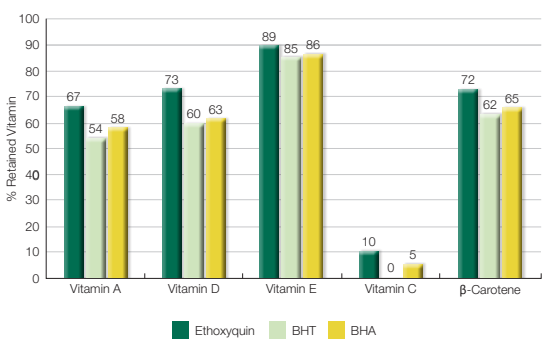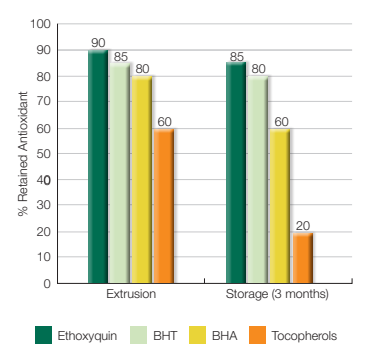Enhanced TDS
Knowde-enriched technical product data sheet
Identification & Functionality
- Ingredient Name
- Animal Feed & Nutrition Functions
- Ingredients
- Ethoxyquin
- Technologies
- Product Families
Features & Benefits
- Animal Feed & Nutrition Features
- Product Highlights
The oxidation of fat from feed and raw materials leads to a loss of nutritional factors (vitamins, pigments, essential fatty acids, etc.) and metabolizable energy, in addition to a reduction of consumption due to the fact that rancidity negatively alters palatability of feed. Furthermore, in the body, oxidation leads to pathologies resulting from deficiency of antioxidants that are part of the diet such as vitamin E, selenium or ascorbic acid, as well as problems arising from the action of the free radicals originated from the oxidative processes. To address this issue, the range CAPSOQUIN, based on ethoxyquin as antioxidant and produced by ITPSA, aims to increase the oxidation resistance and so avoid its negative consequences.
- Benefits
- Provides effective and long term protection of raw materials and compound feed against oxidation processes
- Increases the shelf life and the nutritional value of feed
- Protects the antioxidant nutrients of the diet (vitamin E, selenium…) reducing its demand and preventing from sympthoms of their deficiency in the animals
- Effect on the animal: maintains freshness of carcasses during a longer period of time and increases the metabolic antioxidant activity
- FAO recommends the addition of 700-900 ppm of ethoxyquin for the preservation of fish meal. (Ref: The Production of Fish Meal and Oil. FAO, Document Repository, originated by Fisheries and Aquaculture Dept.)
- Optimal dispersion in mixing processes
Applications & Uses
- Markets
- Applications
- Dosage
The recommended dosage depends on the characteristics of the raw material to be treated as well as on the applied variety of CAPSOQUIN:
- Feedstuffs: 90-150 g/Mt
- Raw materials of animal origin: 200-1000 g/Mt
- Experimental Data
Efficacy of CAPSOQUIN protecting lard against oxidation.
Treatments
(250 ppm)Induction Period (h) Protection Factor¹ Increase of Shelf Life Stability (20°C) Control without antioxidant 13.84 1 0 148 + BHT 21.81 1.58 58 233 + CAPSOQUIN 23.9 1.73 73 255 In vivo effect of the ethoxyquin on the stability of lipids in broilers. Comparison of the effects of the addition of ethoxyquin and vitamin E.
Additive on the Diet Body Fat Ethoxyquin (mg/kg) α-tocopherol (mg/kg) α-tocopherol (mg/kg) Peroxides (meq/kg)
0 0 1.4 27.6 0 10 3.6 18.4 0 30 9 3.1 125 0 2.8 7.7 125 10 6.3 0
Properties
- Physical Form
- Properties
ITPSA Food Capsoquin is an antioxidant for raw materials, compound feed and forage. It is recommended for all domestic species.
Solid Form: Commercial ethoxyquin, mainly consisting on the monomer C₁₄H₁₉NO with inert silicates as carrier, providing products with different fluidity.
Liquid Form: Commercial ethoxyquin, mainly consisting on the monomer C₁₄H₁₉NO. This liquid may darken over time although it does not affect its antioxidant capacity.
Regulatory & Compliance
- Certifications & Compliance
Technical Details & Test Data
- Effect of Antioxidants on the Stability of Vitamins

(Storage Period = 3 Months)
- Comparison of Antioxidants Stability in Feed After Extrusion and Storage.

Packaging & Availability
- Packaging Type
Storage & Handling
- Stability
- Solid Form: Stability of 24 months in its original package (aluminum bags)
- Liquid Form:Stability of 24 months in its original package (metallic drums and IBC containers)